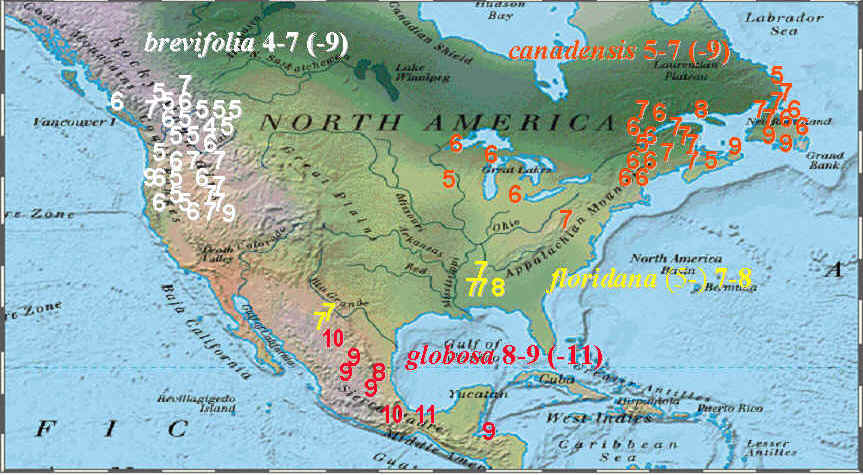
The
World Botanical Associates Web Page
Prepared by Richard W. Spjut, July 1999
Revised May 2000,
April 2003, Nov 2011

| Number of stomata rows per stomata band in leaves of Taxus plotted according to locality data on herbarium specimen labels. |
KEY
1. Leaf epidermal cells as seen in T-section 2. Ventral (abaxial) surface of leaf with 4-10 rows of
trapezoidal to diamond shaped, irregularly widened,
epidermal cells between margin and stomata band; stomata
4-7-(-9) rows/band; Pacific NW (Taxus brevifolia)............ 3
2. Ventral marginal cells of leaves uniformly rectangular to
narrow fusiform; stomata (5-) 7-9 (-11) rows/band............ 5
3. Plant a shrub reproducing by layering (branches), forming
thickets (thicket yew)......... Taxus brevifolia var. reptaneta
Left: habit of plant growing in shade of valley forest
along eastern slopes of Cascades in Oregon. Center and
right: thicket of yew plants in sunny ravine (avalanche
shoot) in NW Montana, defoliated and debarked for chemical
extraction and isolation of taxol; USFS Forester,
David Deevy, pointing to layering branch.3. Plant a tree reproducing by adventitious shoots from trunks
or roots..................................................... 44. Columnar trees; leaves radial, seeds ellipsoid; male cones
maturing in Jul-Aug...................Taxus brevifolia var. nov.4. Trees with one to several trunks, not columnar; leaves
in nearly a two-ranked arrangement; seeds ovoid, male cones
maturing May-Jun, usually falling by early Jul............... 4a4a. Mature cones with scales persisting only as a cup at base (of
cone axis), seed longer than cone axis, usually maturing
on young branchlets as shown below for both male and
female cones (Pacific Yew)....Taxus brevifolia var. brevifolia
Var. brevifolia male and female (seed) cones 4a. Cones with more than one ovule;
scales persistent around the cone axis; seed often
maturing on 2nd yr or older branchlets, notably shorter
than the cone axis .......... Taxus brevifolia var. polychaeta
Var. polychaeta male and female (seed) cones 5. Under (abaxial) surface of leaves appearing less papillose
on midrib and in marginal zones than in stomata bands;
ventral epidermal cells from surface view rectangular to
slightly wedge shaped; Mexico (Nuevo/Tamaulipas, Veracruz),
U.S. (Florida, Florida yew)...... Taxus globosa var. floridana
Var. floridana, abaxial surface from margin to midrib in medial region of leaf, magnified about 250x. 5. Papillae equally prominent on most of the leaf
undersurface to about four cells from margins;
ventral (abaxial) epidermal cells on midrib and
marginal zones mostly fusiform and wavy (incrassate)
along cell walls; El Salvador to NE Mexico
(Mesoamerican Yew)................. Taxus globosa var. globosa
Var. globosa, ventral (abaxial) surface from margin to midrib
in medial region of leaf, magnified about 250x, and abaxial
midrib cells from fresh leaf magnified 400x.6. Stomata bands bordered by smooth marginal and midrib cells,
the marginal cells at least 12 across, papillae often
appearing only within a stomata row; stomata 5-7 (-9)
rows/band; NE Atlantic; Taxus canadensis................... 7
6. Ventral (abaxial) marginal leaf cells usually papillose in
part, the midrib smooth or papillose; stomata 7-13
(-16) rows/band; cultivars................................. 10
7. Trees or shrubs without layering branches, reproducing only
by seeds that mature on shoots of the current season;
introduced from Japan or Korea (Secrest Arboretum), and
with apparent cultivars of hybrid origin...... Taxus biternata
7. Shrubs, usually low, branches often scandent, layering;
seeds often on 2nd yr or older branchlets, occasionally
on both 1st yr and 2nd yr branchlets........................ 8
8. Main branch with branchlets divided into smaller branchlets
of equal length (Canada yew.. Taxus canadensis var. canadensis
8. Branchlets simple to unequally divided, mostly alternate to
nearly opposite along a main branch (subpinnate)............ 9
9. Leaves widely divergent along two sides of branchlets
(two-ranked), oblong, obtuse, the blade abruptly narrowed to
base; rare, Iowa (Rigid-leaf yew)... T. canadensis var. adpressa
9. Leaves bending upwards regardless of branch direction
(erect), acute to acuminate, gradually tapering to
base (Sickle-leaf yew)................T. canadensis var. minor
|